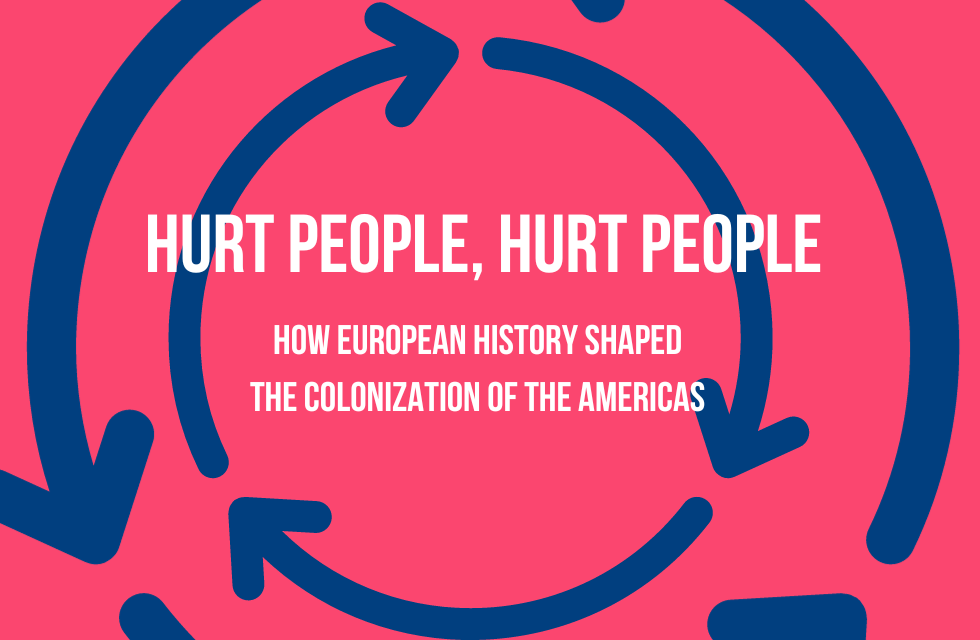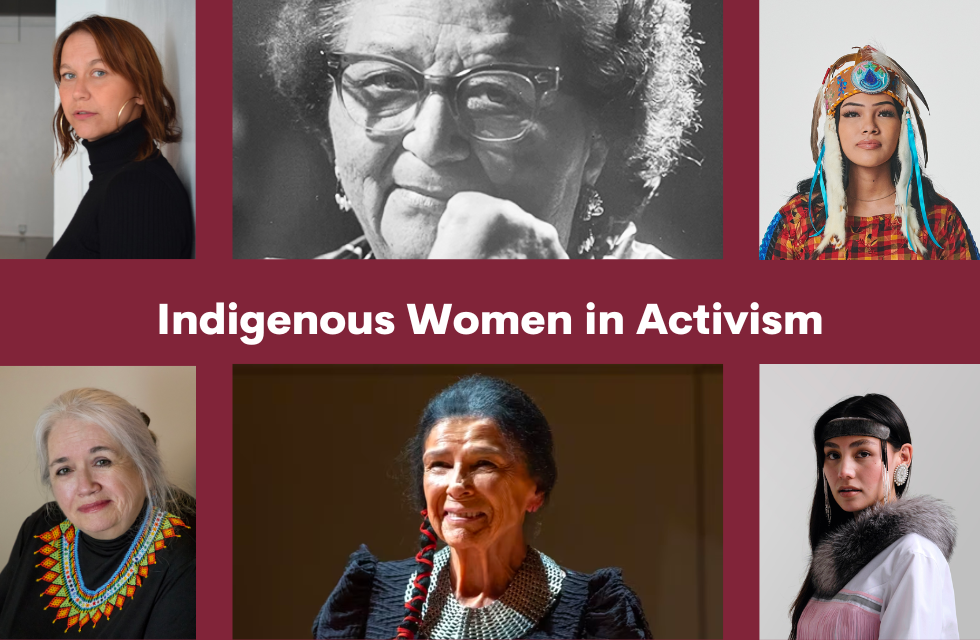In this series, we're highlighting our VERSIONS Alumni. You'll learn about their transformative journeys with…

Hurt people, hurt people: How European history shaped the colonization of the Americas
Ever heard the phrase, “Hurt people hurt people?”
You’ve likely come across it in discussions of bullying. While the statement never excuses a bully’s behaviour, it does offer an explanation of their behavioural origins and perhaps a different perspective. Can the same be said about some of history’s greatest bullies – European colonizers?
This question opened our eyes to the idea that “hurt people hurting people” could also be used to explain colonial history.
We know that white Europeans have a long history of brutally colonizing land and people. But this inhumane behaviour didn’t begin when Columbus stepped foot in the United States. There’s a long history of mistreatment, killing, inhumanity, and brutality throughout Europe that was initially perpetrated against other Europeans. Indigenous philosopher, poet, and actor John Trudel argues that colonizers of the Americas may have been acting out their own version of “hurt people, hurting people.”
Recently, our VERSIONS fellows watched a video recommended to us by Indigenous facilitator and therapist Cheyne Castroni. In the video, John Trudel explores that while Christopher Columbus was a symptom of greater issues, he wasn’t necessarily the origin. Though it’s indisputable that Columbus’s “landing” in America initiated centuries of harm, those ideas didn’t come from him. Instead, Trudel explains that Columbus and his fellow “explorers” came from a long line of people who were accustomed to being horribly abused if they didn’t fit into the status quo, which was primarily based on religious beliefs. For centuries, Europeans had been segregated by class, owned, or oppressed (physically and religiously), subject to torture, separation from family, enslavement, and more. These people were then sent into the ‘new world’ to “discover” new lands and impart their beliefs on the people who lived there, beliefs that were formed through years of trauma.
Medieval Times
A quick European history lesson shows similarities between what life was like in Europe and the oppression enacted by “settlers” to new lands. Between the 5th century, all the way to the 12th, feudalism was prominent in society. This system was founded on communal farming but quickly became an inequitable hierarchy based on greed and prestige.
The feudal pyramid outlines descending statuses where the King sat on top, and beneath him was all the rest: nobles, lords, and serfs at the bottom.

While serfs were given protection and limited rights, they were tied to land from generation to generation, working in poor conditions and bound to a life of servitude. They were confined to the land they worked on–serfs were considered a transferable resource when new ownership claimed land. Under feudalism, there were centuries of abuse and power imbalances, where the poorest people were considered least valuable and had no control over their lives.
We can see general parallels between feudalism and slavery–where people were forced to work the land, had no (or limited) free will, and were mandated to serve a master. However, there are important differences between the two systems. For example, with slavery, enslaved people were considered property to be owned, whereas serfs were bound to the land.
The Influence of the Church
 Religions worldwide have had a long, complex, and often violent history. If we look specifically at the Catholic Church, religious officials forced religious devotion. Through the Inquisition, they punished heresy throughout Europe and eventually into the Americas. Beginning in the 12th century and continuing for hundreds of years after, the Church tortured and persecuted people of other religions–notably Jews and Muslims. Women were also a target of religious persecution, most notably in the witch hunts which plagued European communities for years. Women, often those who were most marginalized, could be condemned as witches, tortured, and burned at the stake for grievances like being left-handed. It was a domineering influence and institution that forced European people to conform and submit to a “higher power.” The Chruch would kill those not following their beliefs or force submission with fear and torture tactics. Their reign of terror shaped the lives and perspectives of many.
Religions worldwide have had a long, complex, and often violent history. If we look specifically at the Catholic Church, religious officials forced religious devotion. Through the Inquisition, they punished heresy throughout Europe and eventually into the Americas. Beginning in the 12th century and continuing for hundreds of years after, the Church tortured and persecuted people of other religions–notably Jews and Muslims. Women were also a target of religious persecution, most notably in the witch hunts which plagued European communities for years. Women, often those who were most marginalized, could be condemned as witches, tortured, and burned at the stake for grievances like being left-handed. It was a domineering influence and institution that forced European people to conform and submit to a “higher power.” The Chruch would kill those not following their beliefs or force submission with fear and torture tactics. Their reign of terror shaped the lives and perspectives of many.
It makes sense that the European “settlers” who came to North America brought with them devout religious beliefs and fear, which were then used to oppress and assimilate Indigenous populations and land. As settlement continued, the Church was at the helm of colonial atrocities like residential schools, where nearly 150,000 children were forcibly removed from their homes and tortured for years in the name of God. Famously, these schools were designed to “kill the Indian in the child.” In America, we see religious slavers using Christianity and the Bible to justify enslaving Black people. They pointed to sections in the Bible that referenced slaves and commanded enslaved people to obey or risk damnation.
Both in European history and in colonial oppression, we see violent tactics to gain power and control. Religion was used to justify atrocities by labelling people “good” and “bad” and enforcing punishments based on “the word of God.”
Racism in Ancient Times
There’s limited evidence that feudalism and the Inquisition targeted people specifically because of race. So, the big question is, how does race come into play?
Race wasn’t always a serious consideration in Europe – likely because most people were of a similar race before mass migration and colonization began. In fact, race is still only recognized as a social construct today, with no biological difference between races. That’s not to say there aren’t very real consequences, but when we look back in history, neither feudalism nor the Inquisition centred their movements around race. They were taught that anything other than what was socially conditioned as “normal” and “good” was brutally punished.
Interestingly, it was only around the time of the Renaissance and Reformation that Europeans were coming into increasing contact with people of darker pigmentation from Africa, Asia, and the Americas. And it was around this time that white Europeans began forming judgments about them. Quickly, dark skin and anyone notably different were grouped into the “other” and seen as savages. This “othering” made it acceptable for Europeans to brutally punish them due to their lack of previous education or understanding of skin tones and cultures. The Europeans, and soon-to-be colonizers, then carried their ignorant beliefs to the “new world” that shaped systems in place for centuries that still impact us today.
Landing in the New World
The cycles of harm we see throughout ancient Europe were replicated in the Americas. Europeans arrived in “new lands” after having experienced centuries of trauma themselves – holding deep beliefs about religion, how societies should operate, and how to use punishment and torture as a means of control and power. The skewed way Europeans seemed to think about social hierarchy was the foundation on which they forced new systems, communities, and industries. While this isn’t an excuse for their actions, it’s important to consider the cycle of harm repeating itself when analyzing colonial history. Hurt people hurt people, and while some of us have been harmed more than others, none of us have been spared from the horrors of complex trauma passed down through generations. Recognizing this and committing to breaking generational cycles, regardless of who your ancestors are, is an important step in building a future in which history doesn’t repeat itself.
the Americas. Europeans arrived in “new lands” after having experienced centuries of trauma themselves – holding deep beliefs about religion, how societies should operate, and how to use punishment and torture as a means of control and power. The skewed way Europeans seemed to think about social hierarchy was the foundation on which they forced new systems, communities, and industries. While this isn’t an excuse for their actions, it’s important to consider the cycle of harm repeating itself when analyzing colonial history. Hurt people hurt people, and while some of us have been harmed more than others, none of us have been spared from the horrors of complex trauma passed down through generations. Recognizing this and committing to breaking generational cycles, regardless of who your ancestors are, is an important step in building a future in which history doesn’t repeat itself.




